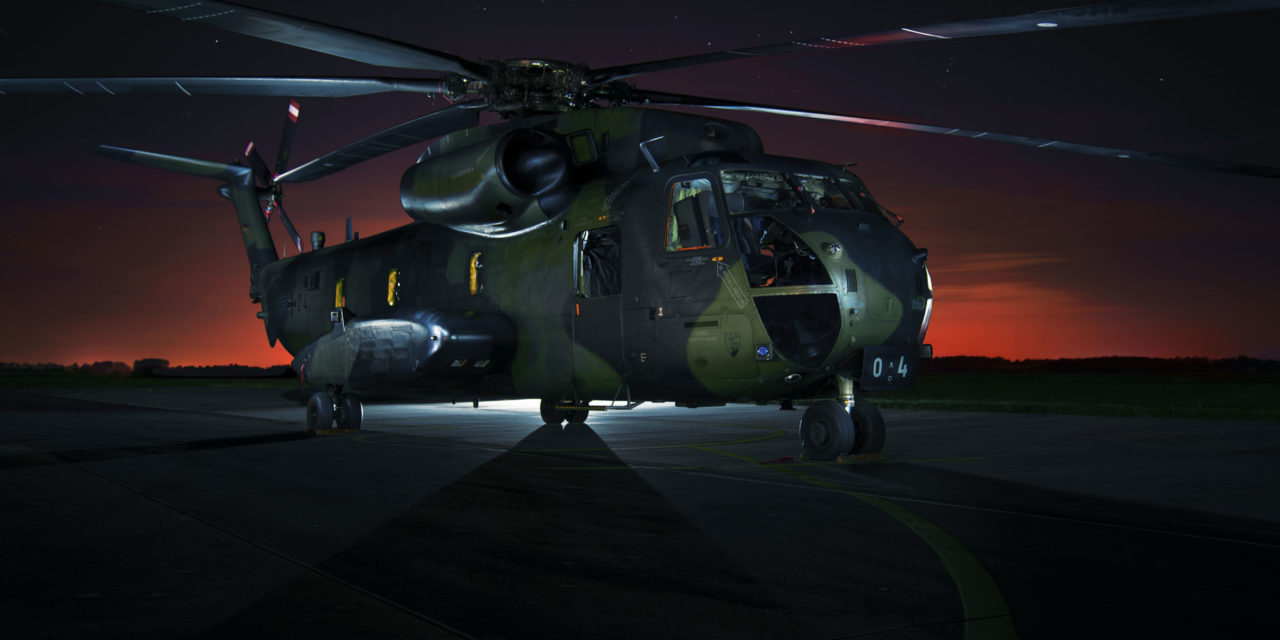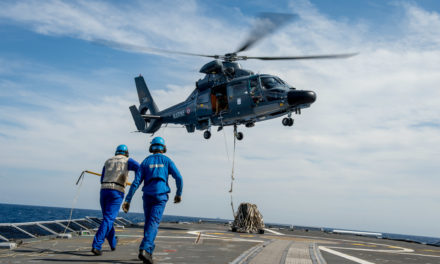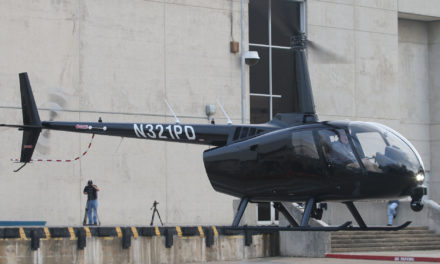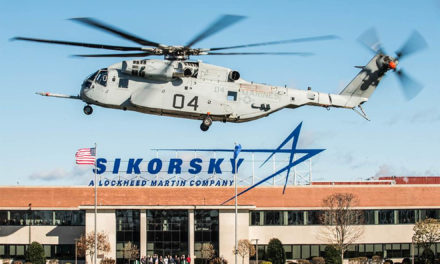HISTORY
Helicopter Transport Wing 64 was founded in 1966. When the wing was disbanded in April 1994, personnel and equipment were absorbed by the other air transport wings of the German Air Force. As Helicopter Wing 64 it was re-established on 1 October 2010 when the helicopters previously assigned to Air Transport Wing 62 and Air Transport Wing 63 formed a new unit.
In 2011, the German armed forces went through a series of structural changes. Because of insufficient funding, the air forces NH90s were concentrated in the army and the air force implemented the former army CH-53. The helicopter wing staff was transferred from Holzdorf to Laupheim.
The wing consists of three flying squadrons on CH-53s and one flying squadron on H145M. The 1st and the 2nd CH-53 squadron are at Laupheim and the 3rd squadron CH-53 is located in Holzdorf. The main task of the 3rd squadron is to do the training missions. They are educating the young pilots when they transfer from basic helicopter training on the EC-135 to the CH-53.
Helicopter Wing 64 is the largest flying wing within the German Armed Forces. Sizewise, it is close to 2,5 Eurofighter wings. The different locations are not easy for wing commander LtCol Christian Mayer. “The distance between Laupheim and Holzdorf is approximately 550km’s. The wing is planning to have an extra location, which will be Diepholz, lower saxony in 2019.”
CH53 VERSIONS
Within the German Air Force, there are four types of CH-53 aircraft. Lt Col Mayer explains: “We have four models: the G, GS, GE, and GA. And the Gs are the oldest, they are the basic model. The GS are the workhorses in the missions abroad because they have the Electronic Warfare systems, upgraded communications systems and they have the external fuel tanks. They still fly with the analog cockpits. The GA model has a digital cockpit but lacks the range and the Electronic Warfare capabilities of the GS version. At the moment we have only 20 GS helicopters.” Because of the age of the helicopters, maintenance takes up a lot of time. That means almost no CH-53GS versions are left in Germany, they are all operating in missions abroad, for example in Afghanistan. Because of the external fuel tanks, the total flight endurance is six hours. As a comparison, the GA model has an endurance of one hour 40 minutes. A short range like this is critical for Afghanistan because there are not many safe landing sites to refuel.
The CH-53GA is an upgraded CH-53Gversion. It has a state of the art cockpit with multifunctional displays and a four-axis autopilot system. It is also equipped with satellite radios and satellite phone.
EDUCATION ON THE CH-53
We spoke to Lt. Col Patrick Schneider* about his experience flying the CH-53 in German service. He has close to 1500 flight hours on the CH-53. Schneider always wanted to be a pilot. He explains: “The basic thing about flying is almost the same in every helicopter, but of course the CH-53 is much bigger. The multi-crew cockpit is also a challenge for the pilot, but it is also easier when you have only a part of the work to do. One pilot is flying and one pilot is monitoring, doing all the cockpit work, working with the radios, taking care of the whole aircrew. There is also a technician in the cockpit supporting the pilot with supervising the engines. As a pilot, you have to do only your pilot job. When you are the aircraft commander you have to make sure that every one of the crew knows what the intentions are, so communication is key” Schneider started as a Bo-105 pilot. “In the Bo-105, a single pilot helicopter, you as the pilot were responsible for everything including radio communication, navigation, technical supervision and taking care of the passengers. Flying the CH-53 is easy. The big challenge of the CH-53 is to know the technical background. In case of an emergency or a malfunction of one of the systems we have to get very much in the technical background of the helicopter.”
One part of the education and conversion to the CH-53 –simulator training- takes part in Bückeburg at the International Helicopter Training Centre. In Bückeburg there are four full mission flight simulators for the CH-53. They are intended for basic handling of the helicopter, how to start the engines, how to perform the all the system checks, how to process the information from the instruments and training of emergencies. Schneider clarifies: “We can perform normal flights in these simulators, but also train tactical flights and do instrument flight training. But the biggest advantage of the simulator might be that you can also train the whole spectrum of malfunctions. We can show our pilots what the helicopter is doing when an engine is on fire or when something happens to the driveshaft affects the whole system. You have to know what your instruments are showing you, how the helicopter sounds and feels like when there is a malfunction.” The basic flight training takes about 1 year. The pilot then has basic knowledge about helicopter flying and has the military license to fly a helicopter. After this year the pilot is transferred to the next helicopter system. From the first theoretic training to be a fully trained pilot in an air wing takes about three to five years. This depends on the availability of the helicopters. Schneider is an instructor pilot since 2010. As an instructor pilot, he works to continue training crews to get them to a higher level.
SPECIAL OPERATIONS
The main task of the CH-53 is to transport personnel and material. But special tasks also include supporting special forces of the army, the Kommando Spezialkräfte (Commando Special Forces, KSK) and navy. In November 2016 the chief of staff of the German Armed Forces decided that only the fourth squadron of the helicopter Wing –the H145M squadron- should be one of the Special Operations units in Germany. Lt Col Christian Mayer just recently became wing commander of the helicopter wing 64. He explains what role the CH-53 has in this: “To give SOF the whole spectrum of transport capabilities they need a helicopter with a size like the H145M, but also like an NH90, Black Hawk or Merlin up to a heavy transport helicopter like the CH-53. So there are always missions where there is a need for the transport capabilities the CH-53 can provide.
PERSONNEL RECOVERY
CH-53s of the Air Force are also performing personnel recovery. Especially the CH-53 GS is very fitting for personnel recovery and search and rescue requirements. It is large so it can contain medics as well as an extraction force, has a good range and has machine guns for self-defense. The CH-53s are also equipped with an electronic warfare system to ensure that ground to air rockets will not hit the helicopter. Lt. Col. Schneider gives an example of why the CH-53 is ideal for this type of missions: “When you look at Bosnia, it was of utmost importance to get downed pilots back safely. They were trying to do that with the UH-1 but found out that the UH-1 is not able to fly as far and carry as much personnel. You need an extraction force in there to go outside the helicopter, identify the personnel on the ground and come back with wounded pilots and return to your operating base.”
FIRE SUPPORT AND FLOOD RELIEF
Another duty is fire support and flood relief. The CH-53 has the capability to carry fire buckets and sling loads under the helicopter. This is not just a national task, in the past German CH-53 helicopters have assisted with wildfires in Greece for example. We also have been in Greece base to support there. In 2002 the Elbe river flooded. Civilians needed to be evacuated, and sandbags needed to be transported to hard to reach areas. Lt. Col. Mayer remembers: “The first day I was flying with my UH-1. I was starting a mission in the morning and flew up for 8-9 hours. We had to rescue the people by hoist from the roofs of houses. After this first day, the rescue mission coordinator asked me to take over his place. At that moment there were about 25 UH-1s and 5 CH-53s flying their missions. About five days later we established the rescue HQ at Holzdorf. This was an extraordinary experience, all of the 20 CH-53 helicopters were flying. There was a lot of metal in the air. It was a logistic super event to see all helicopters returning in the evening. The maintenance personnel did their job and we also flew missions during night time with Night Vision Goggles transporting sandbags to stop the high water.”
MAINTENANCE AND OVERHAUL
Maintenance on the German Ch-53s is done by Airbus. The German government wants to source these contracts locally to make sure there are enough employment opportunities. This way the knowledge about the aircraft will also stay in Germany. The first four helicopters were originally built by Sikorsky, were shipped from the USA to Germany and then manufactured in license by VFW-Fokker at Speyer in Germany.
INTERNATIONAL COOPERATION
Participation in international exercises is limited at the moment due to the availability of the helicopters and the restricted flight hours that come with that problem. This year the exercise focus will be on Special Operations support. A major exercise Lt. Col. Mayer looks to participate in is exercise Angel Thunder in the USA. “Angel Thunder is the biggest personnel recovery exercise in the USA. We have participated with the CH-53 in 2015. The idea is to participate again in the next couple of years. The exercise is very realistic and simulates a complex theater, including fixed wing support from A-10 aircraft for example. But at the moment it is too much to handle, we are focussing on special operations exercises that take place in Europe.
But cooperation with other countries goes further than just visiting exercises. In 2019 the course director for the European APROC personnel Recovery course will be the former 64 Wing Commander. A few young pilots are sent to Israel for basic training on the CH-53. There is an exchange pilot from the U.S. Air Force and from the French Army. They are trained on the CH-53. Ideas from exchange pilots have been implemented before into the squadrons. German CH-53 pilots fly UH-60 Black Hawks, HH-60 Pavehawks in the USA, and Caracals in France.
FUTURE
The end of the lifespan of the German CH-53s is in sight. Mayer: “The CH-53 is an old workhorse and we are coming up to the moment that the CH-53 should be replaced by a heavy transport helicopter.” The choice is the same as in 1966 when the German military evaluated both the CH-53 and CH-47 Chinook. “At the moment talks are based around the CH-47F Chinook and the CH-53K King Stallion. The timeline to start replacing the current CH-53s is set for 2023 and the last CH-53 should be taken out of service in 2030.” The CH-47 will have a lower price, but the CH-53K will have the capability to carry more personnel and cargo. The decision for the future heavy transport helicopter will be made 2019. There are signals that Helicopter Wing 64 will be split into two wings located in Holzdorf and Laupheim with the introduction of the new helicopter.
Wing Commander Mayer is always thinking ahead: “We would like to establish up to two CSAR squadrons to have high-end Personnel Recovery covered and also the training squadrons comparable that we have now at Holzdorf. It is a mixed squadron, a training squadron, and an operational squadron. There is a plan up to four flying squadrons at Laupheim. Three with the heavy transport helicopter and one with the H145M. This is still a rough plan. And three flying squadrons with heavy transport helicopter at Holzdorf.”
He has faith in the future: “All the people here are highly motivated with different backgrounds, which is good, it allows coming up with good and different ideas. I think this is an excellent Wing that is prepared for the future.”
*Because of operational security, the name Patrick Schneider is fictitious.
Text by Jeroen van Veenendaal – DutchAviationPhoto.com
















